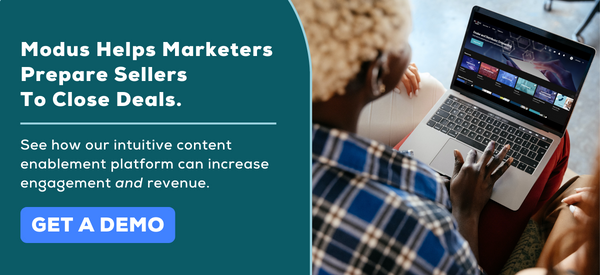There's a paradigm shift in sales enablement. More than ever before, sellers and marketers are struggling to:
| ✔️ Engage buyers. | ✔️ Maximize content usage. |
| ✔️ Optimize selling time. | ✔️ And achieve ROI. |
An assessment of sales outcomes as of 2022 found that only 24.3% of sellers exceeded quota and nearly half of the opportunities resulted in no decision to change from the status quo.
Sales reps don’t use content to their advantage, and marketers are under pressure to prove return on investment. And a mere 9% of B2B organizations say they optimize around placing buyers at the center of their sales enablement strategies.
When asked how sellers are measuring up with the recent shift to more virtual sales interactions, buyers aren’t bowled over.
The chart below shows how buyers rate sellers at meeting the top four most important influences on their decision process, per research from Rain Group:

Selling takes a coordinated effort from both marketers and sellers to be successful. Marketing and sales alignment has been a source of frustration from both sides for decades.
Below, you'll see that it remains an ongoing challenge for companies.

We know that a big part of the problem lies in content. It's not easy to find, organized, the most current and up-to-date. Oftentimes, we find that once sellers find something they deem valuable, they'll download it so it's always accessible. However, there's no way to ensure the version remains updated.
Sales enablement helps solve these challenges—and in a way that’s beneficial to both sales and marketing teams as well as buyers. Businesses leveraging the right enablement platform see ROI through increased efficiencies in their organizations and reduced sales cycles.
6 Sources of ROI from Sales Enablement
CSO Insights found that organizations with a formal sales enablement charter in place have average win rates of 55.1%, far above those without.
Below are some of the ways your business can realize ROI by implementing sales enablement.
1. Helping Sales Reps Gain Selling Time
Sales reps spend an average of 9 hours per week searching for and customizing content. If your average base salary for a sales rep is $100K—fully loaded—that’s $22,500 per rep/per year, you’re paying them to look for and customize content.
By consolidating sales content into a central library and enabling instant access, online or offline, a reduction of 65% in time spent lowers costs by $14,625 per rep. With 50 reps, that adds up to $731,250 in savings per year.
Even better, you’ve now given reps nearly 6 hours back per week they can spend on activities related to selling.
Another way to measure this outcome is by the increased number of transactions (calls, meetings, outreach) your reps participate in each week compared to their current benchmark. Over time, this increase in selling time will result in a reduction in sales cycle time and an increase in win rates—both measurable and a win for your sales team, but also one you can point to as aided by marketing.
2. (AND 3.) Increased Use of Sales Content in Support of Buyer Conversations | Visibility into Content Influential to Deals Won to Prove Contribution to Revenue
Corporate Visions research finds that up to 90% of content created by marketing goes unused by sales reps—that's a big number! There are many reasons for this, but it's primarily that there’s too much content and it’s too hard to find. Additionally, there’s concern by reps that content is outdated or irrelevant to buyers. Many reps also don’t know how to use content to their best advantage with buyers to initiate or continue conversations—even if they can find it.
Sales enablement helps solve this problem. First, content usage increases due because reps are able to find it. If it's easily organized into Collections that make sense for different product lines or initiatives, reps easily find what they need to advance deals.
Plus, it's easy for marketers to match bite-size chunks of training with content giving reps key points and takeaways so they can use it in buyer conversations, follow-up, and outreach. Bannners and What's New features help call out internal company initiatives to get reps up to speed quickly.
Marketers also have many ways to tag content to ensure that it’s used at the appropriate time, for the right persona, product, buying stage, and business solution. AI tagging that includes reading PDFs reduces manual effort for marketers, as well.
A platform with value-add analytics that are easy to read allowing you to see and measure your reps’ activity and content usage. You’ll know which content reps use most. And also understand which content buyers are engaging with so that you can create more of it.
The ROI here is in being able to prove content’s contribution to win deals and drive pipeline velocity. You’ll also reap the rewards of having valuable insights about which content moves the dial to improve your content marketing strategy, and for sales to improve outreach.
4. Better Buyer Engagement, Deal Progression & Win Rates
Sales enablement is not just about getting sellers access to content. While content distribution through a centralized repository is an inciting factor, sales enablement should also provide tools that help sellers step up their game.
Just-in-time learning helps reinforce tactics and traditional sales training so it's easily digestable for relevant buyer conversations. Nearly 60% of your employees prefer self-paced training on demand, including your sellers, and 49% of sellers want to learn in the flow of work.
Microlearning helps sellers engage buyers and make progress by facilitating better discovery, showing them what’s possible, and proving ROI—things buyers currently say most sellers are not doing well, but that highly influence their purchase decisions.
Part of the art of selling is in the follow-up that keeps deals progressing. Digital Sales Rooms (DSRs)—think interactive microsites specific to a prospect’s buying team—help your sellers build quality engagement with buyers and satisfy their need for self-service during their buying process.
Gartner predicts that by 2025, 50% of all enterprise sales technology implementations will include DSRs.
5. Improved Integration and Collaboration for Marketing and Sales Teams
2023 data shows that only 10-15% of leads make it to the bottom of a sales funnel and convert to deals. Buyers taking control of their buying process through self-service research and holding sellers at arm’s length until they’re ready to engage has played a role. A lack of alignment and disconnection between marketing and sales also has an impact on this.
A content enablement platform helps you shift to an integrated approach between marketing and sales efforts. It helps focus on buyer enablement, which is growing in importance given your customers’ (likely convoluted) buying process. Why is this important? Because sales and marketing alignment can lead to a 32% increase in year-over-year revenue growth.
A sales enablement platform naturally pulls marketing and sales closer together. Marketing is providing content and tools sales reps need and the analytics help both teams understand what’s working and what’s not.
As you use insights to refine content and increase the ability to deliver buyer enablement, marketing, and sales present a unified end-to-end buying experience. This helps sellers win more often as buyers see a clear path to solving their business challenges.
6. Connect Data Across Systems Automatically
Modus provides a combination of native integrations to connect your existing systems, automatically syncing data to eliminate manual effort and remove silos that impede growth.
You’ve made investments in systems. There’s no need to give up your DAM or Repository of record to implement sales enablement. Instead, integrations just help you get more bang for the spend you’re already making with less effort or need to move between systems for all involved.
In Summary:
While the ROI of sales enablement comes from multiple sources, the biggest contributing factor per the Forrester research is time saved to apply toward selling—which is reflected in more transactions/meetings.
There are additional sources of value, like visibility and insights. Visibility is what gives sellers more time, gets content used, helps you understand which content is driving deals and most effective at enabling your buyers. Visibility also helps you integrate with sales to increase consistency in buyer experiences, driving momentum.
A softer value that’s harder to measure is the confidence sellers gain when they have easy access to the internal and external content, and on-demand training they need to have better, more relevant conversations with buyers. Tools like DSRs deliver value through ongoing buyer conversations to move deals forward.
The overall outcome is improving your organization’s go-to-market strategy to help sellers sell, increase revenue and drive company growth.

![→ Watch Now: Modus Explains How to Simplify Sales Enablement [VIDEO]](images/9d3770e1-599f-49cc-acdc-7b98d2056e11.png)


